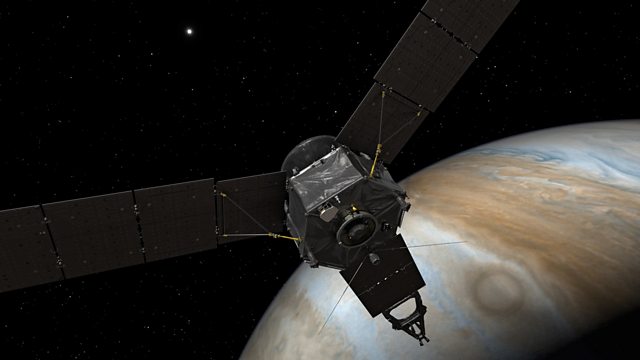
Juno Space Mission Approaches Jupiter
Juno; Irritable Bonobos; Sex Life of animals; Celebratory gunfire; Life on the East Asian Flyway; Antarctic Ozone Hole; Helium discovery; Nanotechnology in art
Nasa's Juno Probe arrives at Jupiter on 4th July, where it will execute a daring loop-the-loop in order to get closer to the giant planet than any other spacecraft in history. Juno is constructed like an armoured tank, because Jupiter is surrounded by a belt of very intense radiation that can quickly fry most spacecraft electronics. On July 4, Juno's engines will attempt to slow the probe down so it can be sucked into Jupiter's orbit. The slightest error could mean Juno misses this window, putting an end to the $1.1 billion mission. The man in charge is Dr Scott Bolton, and he speaks to Adam Rutherford from Pasadena in California.
Irritable Bonobos
Female bonobos are a feisty bunch. They have dominant, high-status roles within bonobo society, in stark contrast to the more marginalised role that females play in chimpanzee groups. It might therefore not surprise you to find that female bonobos show higher levels of irritability than male bonobos, who in turn are more introverted. These are among the findings of a detailed personality test on bonobos. It is the first time such a test has been undertaken in the wild.
Sex Life of Animals
Increasingly, scientists are starting to re-evaluate the gender behaviours in different species of animals. The thinking is that because Charles Darwin lived in a world of nineteenth century propriety, his thinking on sexual selection may have been shaped by his perception of human society at that time. Increasingly, it seems that animals of different species, even those previously thought of as archetypes of monogamy, seem to lead much more complicated social and sexual lives.
Celebratory Gunfire
Today some victims of gunshot wounds are far from a battlefield. In countries like Afghanistan, Pakistan, parts of India and Latin America, so-called “celebratory” gunfire involves firing weapons up into the air in order to mark a positive event. They are often considered to be a harmless show of strength or bravado, but Hugo Goodridge reports from the Lebanese capital Beirut, where a number of people have been killed or injured by guns fired in the city. It is illegal to discharge a gun in a public place in Lebanon and the police have used social media to try and change attitudes towards celebratory gunfire.
Life on the East Asian Flyway
After flying thousands of kilometres from faraway Bangladesh and New Zealand via the Yellow Sea, the shorebirds of the East Asian Flyway complete their northward migration. They touch down in the Russian Arctic and Alaska to breed. One species conservationists are particularly concerned about is the endangered spoon bill sandpiper that reaches the Arctic in May and June. Ann Jones has been finding out how they are helping to encourage the survival of the spoon-billed sandpiper.
Antarctic Ozone Hole Is Finally Closing
Thirty years ago researchers linked the Ozone Hole in Antarctica with the use of chlorine- and bromine-based sprays. There followed an immediate worldwide ban. Scientists only very recently detected the slow healing process in the Ozone layer at the South Pole. However, external factors, such as atmospheric particles resulting from recent volcanic eruptions, are disrupting this recovery.
Helium Discovery
Scientists have discovered a large helium gas field in Tanzania. With world supplies running out, the find is a "game-changer", say geologists at Durham and Oxford universities. Helium is used in hospitals in MRI scanners as well as in spacecraft, telescopes and radiation monitors. Until now, the precious gas has been discovered only in small quantities during oil and gas drilling. Using a new exploration approach, researchers found large quantities of helium within the Tanzanian East African Rift Valley. They say resources in just one part of the Rift valley are enough to fill more than a million medical MRI scanners. Helen Briggs reports on this find.
Nanotechnology in Art
Dr Rob Thompson explores science being applied in art conservation. Meeting up with members of the European NanoRestArt project Rob learns how experimental materials have led to modern art being some of the most vulnerable pieces of our cultural heritage. Could science and nanotechnology come to the rescue and should they?
(Image caption: This illustration depicts Nasa’s Juno spacecraft at Jupiter, with its solar arrays and main antenna pointed toward the distant sun and Earth © Nasa/JPL-Caltech)
The Science Hour was presented by Tracey Logan with comments from Melissa Hogenboom and David Robson
Producer: Alex Mansfield
Last on
More episodes
Previous
Next
Broadcasts
- Sat 2 Jul 2016 08:06GMT����ý World Service Australasia
- Sat 2 Jul 2016 22:06GMT����ý World Service except News Internet
- Sun 3 Jul 2016 01:06GMT����ý World Service Australasia
- Sun 3 Jul 2016 16:06GMT����ý World Service Online
- Mon 4 Jul 2016 05:06GMT����ý World Service South Asia
Podcast
-
![]()
Unexpected Elements
The news you know, the science you don't

